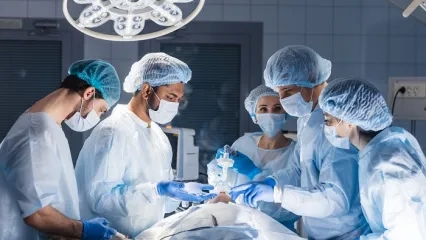Alo Yeditepe
Alo Yeditepe
What are the Problems Requiring Gallbladder Surgery?
Gallbladder Surgery
The most common cause of gallbladder surgery is gallstones. Although these stones are usually asymptomatic, some patients may experience pain, indigestion, bloating, nausea and discomfort in the right upper abdomen, especially after meals..
More serious cases include:
Gallbladder Inflammation (Cholecystitis)
Inflammation may develop when gallstones damage the gallbladder. It is characterised by high fever, severe abdominal pain and signs of infection.
Main bile duct stones (choledocholithiasis)
Gallstones falling into the main bile duct causing obstruction and jaundice.
Gall Bladder Mud
Microstones and sludge can accumulate over time and cause inflammation or blockage.
Gallbladder Polyps
Large and suspicious polyps may carry cancer risk.
Prevalence of Gallbladder Problems
Gallstones are seen in 10-15% of the population. It is more common in individuals over the age of 40, women, and people with risk factors such as diabetes and obesity. Millions of people worldwide undergo gallbladder surgery every year.
What are the Symptoms of Gallbladder Stones?
Gallstones sometimes cause no symptoms and are detected by chance. However, various symptoms can occur when stones block the flow of bile or cause inflammation in the gallbladder. Among the symptoms of gallstones, it is possible to list the following:
Abdominal Pain
It is usually felt in the upper right or middle part of the abdomen. The pain may intensify after meals, especially after fatty foods, and may last for several hours.
Pain in the back and shoulder area
Pain may radiate to the right shoulder or right side of the back.
Nausea and Vomiting
People with gallstones may experience nausea and sometimes vomiting.
Indigestion and Bloating
Discomfort in the stomach, gas and bloating, especially when fatty foods are consumed.
Jaundice
If gallstones block the bile ducts, yellowing of the skin and eyes (jaundice), dark urine and light-coloured stools may occur.
Fever and Chills
If the gallbladder becomes inflamed (cholecystitis), fever and chills may occur. If any of these symptoms become severe or persist for a long time, it is important to consult a doctor.
Do Gallstones Always Require Surgery?
Not all gallstones require surgery. Stones that do not cause complaints can be followed up. However, surgery can be planned earlier in people in the risk group such as diabetic patients..
Supportive therapies:
Wait-and-see Approach: Monitored until symptoms occur.
Endoscopic Retrograde Cholangiopancreatography (ERCP): It is a technique used to remove stones that fall into the bile duct.
Percutaneous Cholecystostomy: It is the procedure of draining the gallbladder with a catheter through the skin for patients who cannot tolerate surgery.
What happens if gallbladder surgery is delayed?
If the operation is delayed or not performed, the following complications may develop:
Acute Cholecystitis
Increased inflammation of the gallbladder and risk of infection. If left untreated, the inflammation can progress and lead to gangrenisation (tissue death) or perforation.
Choledocholithiasis (main bile duct stones) and jaundice
If stones fall into the bile ducts, the common bile duct (choledochal duct) can become blocked and bile flow is impeded. In this case, the patient may experience symptoms such as jaundice, dark urine, light-coloured stools and severe itching..
Pancreatitis
Stones falling into the common bile duct can lead to pancreatitis.
Peritonitis
Spread of infection to the peritoneum. Early surgical planning is safer than the need for emergency surgery.
How Gallbladder Surgery is Performed?
Thanks to modern surgical methods, gallbladder surgeries are performed with minimally invasive techniques:
Laparoscopic Cholecystectomy
It is a surgical method that is performed with small incisions and provides rapid healing. Laparoscopic surgery is performed through small incisions, which speeds up the healing process. During the operation, several small holes are made in the abdomen and a camera is inserted through one of these holes. The camera allows the surgeon to see the organs clearly. Through the other holes, the gallbladder is removed with small instruments. The biggest advantage of the laparoscopic method is that it provides less pain and faster recovery. Patients can usually be discharged within 1-2 days and can return to their daily lives very quickly. In addition, since small holes are used instead of large incisions, scars are less and the risk of infection is low. In short, this type of surgery is both safer and offers a more comfortable recovery process for patients.
SILS (Single Incision Laparoscopic Surgery)
It is performed through a single incision made through the navel.
Mini-Lap Cholecystectomy
It is a method performed through a smaller incision compared to traditional open surgery. Today, gallbladder surgery is performed much more safely and comfortably thanks to minimally invasive surgical techniques. Alternative treatment methods and advanced imaging techniques minimise the risk of complications and provide the best results for patients.
What is ICG Fluorescence Cholangiography Method?
ICG (Indocyanine Green) fluorescent cholangiography is an advanced imaging technique that allows a better view of the biliary tract during surgery. The ICG substance, which is administered intravenously to the patient before the operation, is processed by the liver and passes into the biliary tract and can be visualised with a special camera during the operation.
Advantages of ICG
• Helps to see anatomical structures clearly during surgery.
• It prevents bile duct injuries.
• It is safer than conventional methods and does not involve extra radiation.
• In particularly difficult cases, according to the Tokyo Guidelines:
• Acute cases of cholecystitis with severe inflammation or adhesions,
• Patients with previous upper abdominal surgery,
• This technique is of great advantage in patients with anatomical differences such as Mirizzi syndrome.
ICG fluorescence imaging reduces the risk of surgeon error during surgery and makes the operation safer. This advanced technique is one of the most important innovations offered by minimally invasive surgery.
What Should Patients Who Have Gallbladder Removal Pay Attention To?
Patients who have their gallbladder removed can usually lead a healthy life. However, some patients may temporarily experience problems such as indigestion and bloating. A healthy diet and regular exercise minimise such problems. After gallbladder removal, a healthy lifestyle and balanced diet help prevent potential problems. Most patients can live healthily for many years without any serious health problems as long as they follow the doctor's recommendations.
This content was prepared by Yeditepe University Hospitals Medical Editorial Board.
”
See Also
- Fall from Height Led to Kidney Failure, Saved by Sister's Donation
- What is a Liver Transplant, How is it Done? and Who is it For?
- Journey of Hope from Georgia to Turkey: 63-Year-Old Father Donates Kidney to Son
- Birthday Gift Becomes a Gift of Life: Kidney Donation from Husband of 20 Years
- Can Liver Cancer Be Prevented?
- Common Misconceptions About Kidney Transplantation
- 19 Years Old Davut MİNAZ, Who Lost 45 Kilos in 4 Months, Clung to Life with His Father's Kidney
- Gallbladder Surgery is a Necessity, Not a Choice
- What is Organ Donation?
- Liver Cancer (Tumor) and Treatment
- What is a Kidney Transplant?
Alo Yeditepe




